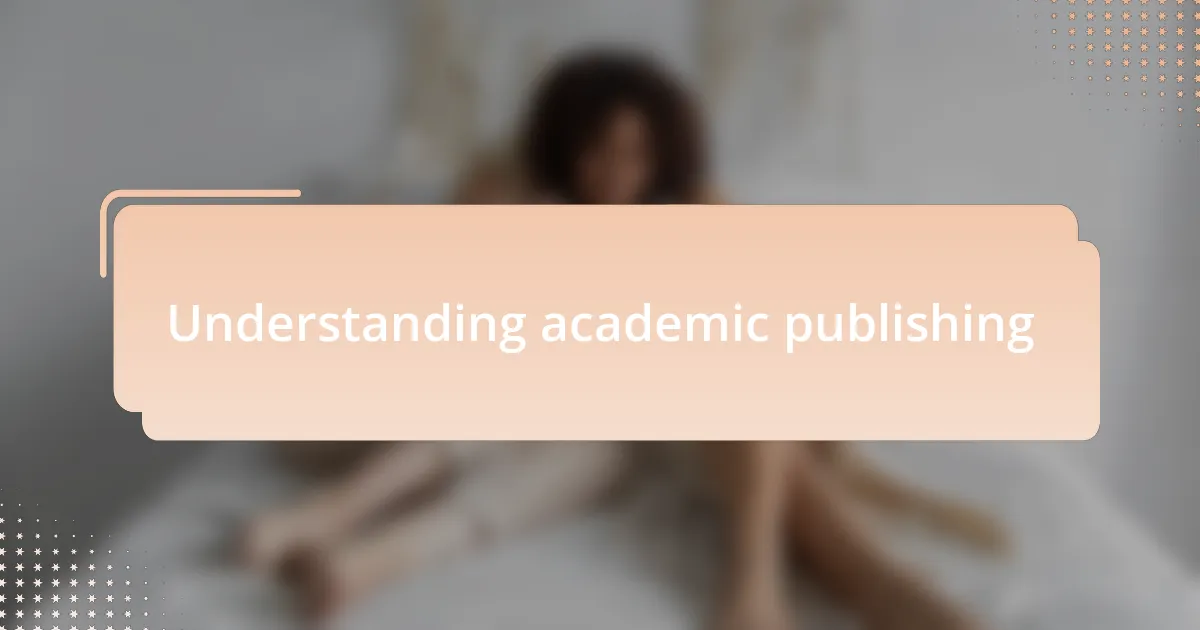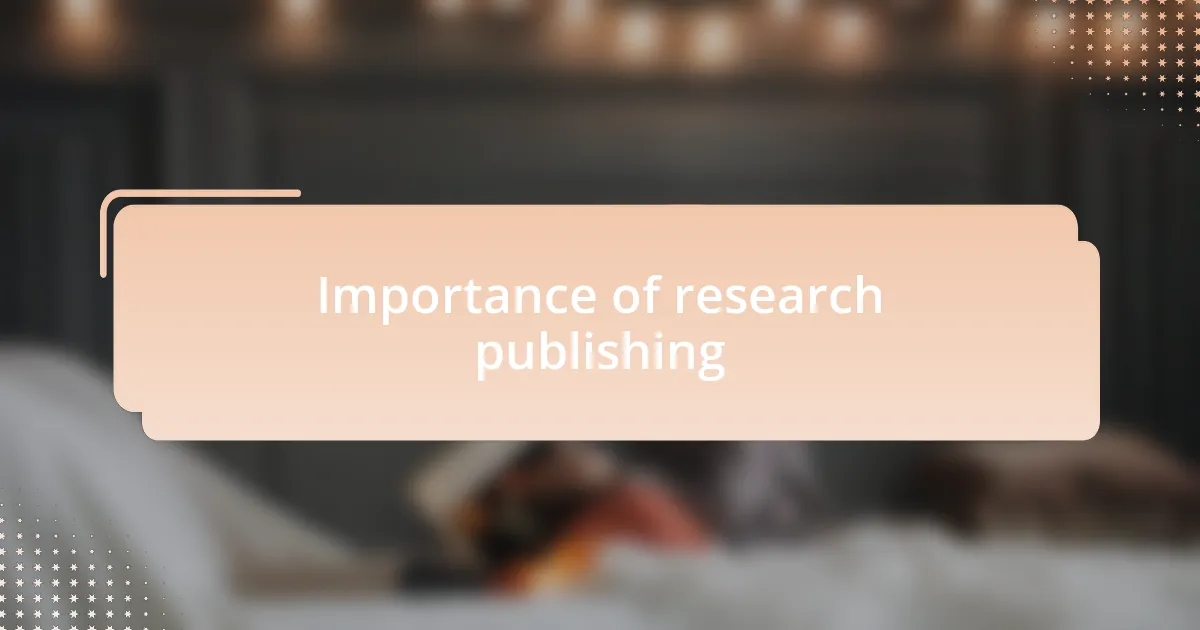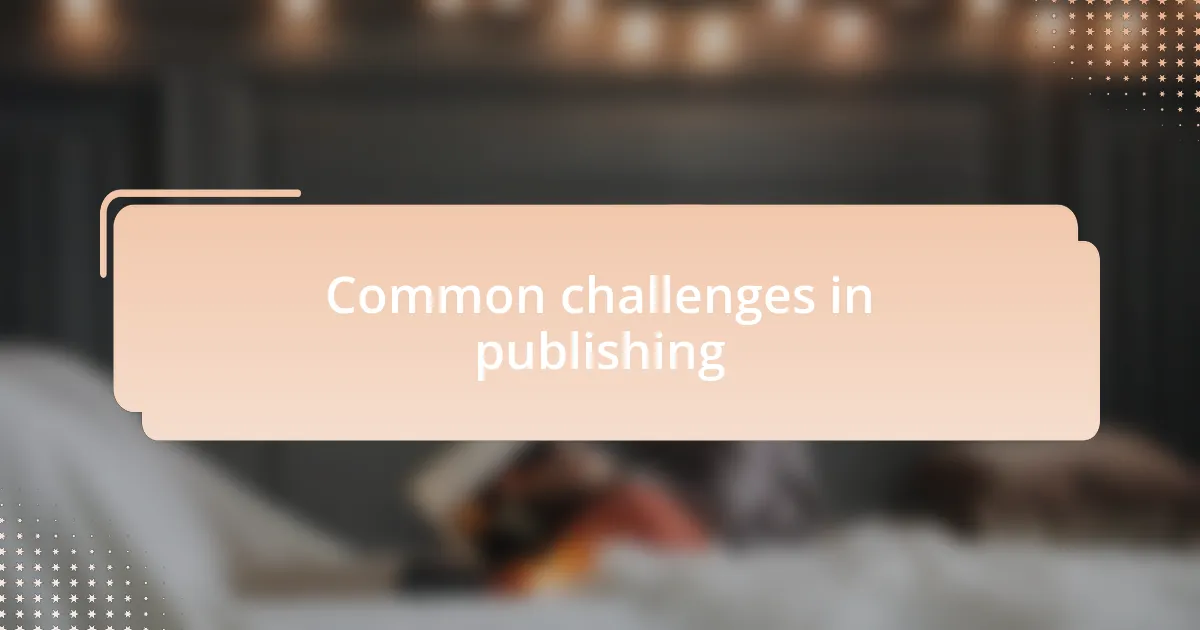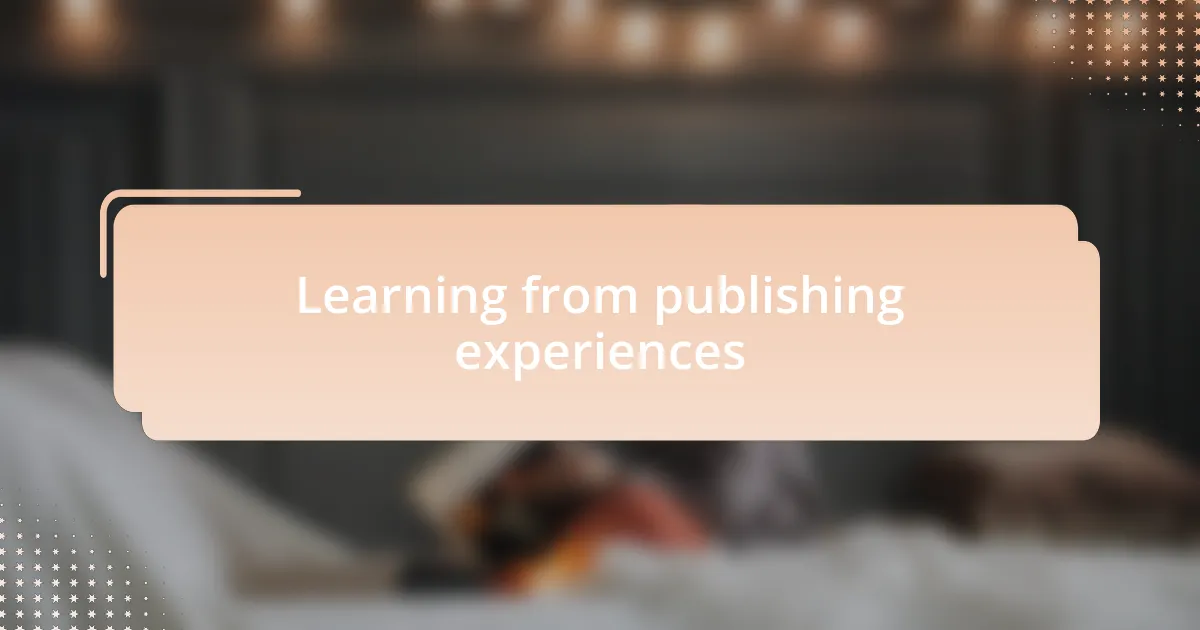Key takeaways:
- Understanding the peer-review process and selecting the right journal are crucial for successful academic publishing.
- Publishing research enhances credibility and establishes professional identity, while also refining writing and thinking skills.
- Common challenges include harsh peer reviews, lengthy publication processes, and understanding copyright issues; managing expectations is essential.
- Preparing a manuscript involves adhering to submission guidelines, creating outlines, and seeking feedback to strengthen the work.

Understanding academic publishing
Understanding academic publishing is crucial if you want to navigate the intricate world of scholarly communication. I remember when I first tackled this daunting landscape; I felt like I was stepping into a maze without a map. The sheer volume of journals, each with its unique focus and submission guidelines, can be overwhelming. Have you ever found yourself wondering where to even begin? Trust me, you’re not alone.
One of the most surprising aspects of academic publishing is the lengthy peer-review process. When I submitted my first paper, I was eager for feedback, believing it would be swift. Instead, I learned that good things take time, and patience is a vital part of the journey. I often wish someone had shared that with me earlier; understanding this can help manage expectations and reduce frustration.
Moreover, the importance of selecting the right journal cannot be overstated. Reflecting on my experience, I realized that not every paper fits into every journal. I once submitted a piece to a high-impact journal only to see it returned with a polite rejection. Recognizing the specific audience and scope of a journal can significantly influence, if not dictate, the success of your publication efforts. How do you ensure your work reaches the right readers? It’s about aligning your research with the journal’s goals, a lesson I learned the hard way.

Importance of research publishing
Publishing research is fundamentally important for advancing knowledge within any field. I still remember the excitement when I first saw my work in print; it felt like I was contributing to a larger conversation. Each published study not only enhances one’s credibility but also helps to share findings, sparking further inquiry and discussion. Isn’t it fascinating how a single paper can inspire countless new ideas and research projects?
Moreover, being published establishes a researcher’s professional identity. Early in my career, I realized that visibility matters. The more I published, the more recognition I gained in my academic community. This visibility can open doors for collaboration, funding opportunities, and even teaching roles. It made me ponder: how can we expect our work to be taken seriously if we don’t share it?
Additionally, the process of publishing helps refine our thinking and writing skills. Reflecting on my journey, I can affirm that drafting and revising for publication forces clarity and precision. Each round of revisions is not just a hurdle but an opportunity for growth. It’s a rigorous process, no doubt, but through it, I learned the invaluable lesson of articulating complex ideas in ways that others can understand. Isn’t that what we all strive for?

Common challenges in publishing
Navigating the publishing landscape can often feel like traversing a maze filled with unexpected twists and turns. I vividly recall the frustration of receiving peer reviews filled with critiques that, at first glance, seemed overwhelmingly harsh. It prompted me to reflect: how often do you really risk vulnerability when putting your work out there? Those reviews, while daunting, ultimately became a treasure trove of insights that helped me refine my arguments.
Another challenge I faced was the sheer length of the process. I remember submitting my first paper and picturing a swift journey to publication, only to find myself stuck in a lengthy review cycle. The waiting game can be agonizing, can’t it? I learned to manage my expectations and instead use that time for new projects, turning what once felt like a setback into an opportunity for growth.
Lastly, understanding copyright and publication rights was another hurdle that tripped me up. Early on, I made the mistake of assuming my work was mine alone, not realizing the complexities involved in sharing it with a wider audience. It made me question: do we really grasp what we’re signing away sometimes? Learning to navigate this aspect not only empowered me but also ensured that my work was protected while reaching those who could benefit from it.

Steps to prepare your manuscript
Preparing your manuscript is a crucial step that can significantly influence your publishing experience. One of the first things I did was to closely read the journal’s submission guidelines. I remember the first time I neglected this step and ended up having my manuscript returned due to formatting issues. It felt like a simple oversight, but those guidelines can be a make-or-break factor. Have you ever overlooked something seemingly minor only to face big consequences later?
Next, I found creating a detailed outline to be incredibly helpful. Mapping out my arguments not only organized my thoughts but also revealed gaps in my research. When I went through my outline for a recent paper, I discovered a point that needed more evidence, preventing me from facing potentially embarrassing questions during peer review. Isn’t it amazing how a simple outline can pave the way for a stronger argument?
Finally, I can’t stress enough the importance of seeking feedback before the final submission. I used to shy away from sharing my drafts, thinking they needed to be perfect first. But once I started inviting feedback from colleagues, I realized how much I could enhance my work. There’s an undeniable power in collaboration; have you thought about how others could enrich your writing? It’s often through these conversations that we uncover the most critical insights.

Tips for a successful submission
When it comes to successful submission, one of the best tips I can share is to tailor your manuscript to the journal’s audience. Early in my career, I submitted a paper that I thought was groundbreaking, but it didn’t quite fit the journal’s focus. This misalignment not only wasted my time but also felt disheartening. Have you ever put in so much effort, only to realize it wasn’t where it needed to be?
Another crucial aspect is to pay attention to clarity and conciseness. During my first few submissions, I noticed that my work often got bogged down by overly complex sentences. I learned that a clearer, more straightforward style made my arguments pop, allowing reviewers to grasp my points without straining. How could clarity in your writing change the way your ideas are received?
Lastly, ensure that your references are comprehensive and formatted correctly. In one instance, I received feedback pointing out several missing citations that weren’t just overlooked—they were key to supporting my arguments. This experience reminded me just how critical thoroughness is in academic publishing. It’s not only about what you say; it’s also about proving it. What checks can you implement to avoid this common pitfall?

Learning from publishing experiences
There’s a unique learning curve that comes with each publication experience. I recall a time when I received extensive reviewer comments that initially felt overwhelming. However, as I dissected their feedback, I realized they were invaluable insights into improving not just that paper, but my overall research approach. Have you ever experienced criticism that, although tough to hear, led you to a breakthrough in your work?
In another instance, I learned the importance of collaboration through a co-authored paper. It was enlightening to witness how different perspectives can enhance a manuscript. At first, I was reluctant to compromise, but I found that integrating my colleague’s ideas enriched my own, making the final product much stronger. What do you think collaborating could teach you about your own writing style?
Moreover, I once faced a disheartening rejection that initially felt like a dead end. Instead of giving up, I took a step back and viewed it as a learning opportunity. Revisiting my work later allowed me to identify gaps and refine my arguments. Have you ever turned a setback into a stepping stone for growth?